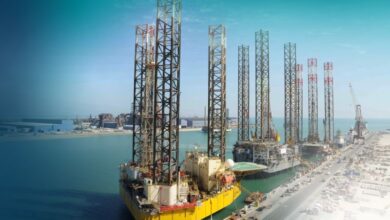HSE&T Corner – Renewed focus on dropped object prevention needed as cost pressures, rig reactivations and personnel turnover amplify risks
By Mike Rice, Dropsafe

According to industry body DROPS, dropped objects are among the top 10 causes of injury and fatality in oil and gas operations. Yet, dropped objects are also one of the only HSE areas without standardized legislation. This leaves individual project management teams solely responsible for ensuring the integrity of operational sites.
This discrepancy has contributed to an increase, in real terms, of dropped object incidents in recent years. While oil and gas activity levels have declined with the fall in oil prices, the numbers of incidents have not decreased accordingly.
However, the industry – including drilling contractors – has recently renewed its focus on drops prevention. For example, one major international drilling contractor recently issued a fleetwide safety briefing on dropped objects to personnel to reinforce the importance of being continually alert to the risks. The same contractor is also looking at installing barrier systems along the guardrails of walkways and other traffic areas to prevent objects from falling through.
The changing industry landscape threatens to increase risks further. To address these challenges, drilling contractors and oil and gas managers must self-regulate – educating their personnel, investing in durable solutions and adapting these solutions to fit the requirements of each project site.
What risks do dropped objects pose?
Dropped object incidents fall into one of two categories: static or dynamic. As the name suggests, the former includes fixed objects – such as lights and CCTV cameras – that fall from height, perhaps due to failure of the mounting bracket caused by corrosion, vibration or poor maintenance. The size of these objects threatens not only the safety of personnel, should they fall, but also critical equipment in the potential impact zone.
Dynamic objects, by contrast, include handheld items that are carried around by personnel, such as tools, handheld radios and gas detectors. Personnel working at height – in a derrick, or on a raised walkway – are at risk of dropping these objects – which, if they collide with another worker below, can cause injury or possible fatality.
The scale of the problem is illustrated by one major international oil and gas company’s 2017 report showing that 68% of its high-potential incidents (HiPos) were caused by dropped objects.
For the companies involved with projects on which incidents and near-misses take place, the consequences are significant. Not only is the safety of individual personnel threatened, but the financial, reputational and even legal ramifications of such an incident leave both the oil and gas company and project contractors vulnerable.
The changing risk landscape
Meanwhile, three market trends in the industry are set to increase the risks from dropped objects further. These are continued cost pressures, stacked rigs being brought out of storage, and personnel turnover causing gaps in best practice.
Price variation has always posed a challenge to the industry. Despite the recent upturn in oil prices, this revenue uncertainty remains. The industry responds to this by exerting downward pressure on the supply chain, which threatens to cause underinvestment in the most robust safety solutions available.
Finally, senior industry workers, leaving for retirement or other offshore sectors, take with them years of experience and lessons learned, both of which are important for minimizing incidences of dropped objects.
How can these risks be mitigated?
Encouragingly, these increasing risks are matched by an increasing awareness, among leading oil and gas companies and contractors, of the challenges posed by dropped objects. Accordingly, the demand for efficient safety solutions has risen in recent years, as decision-makers take preventive measures to avoid dangerous and damaging dropped objects incidents.
The solutions in demand include stainless steel mesh nets to enclose static objects at height, such as lights and cameras, as well as solutions to dynamic dropped objects. These include barriers that can be fixed to open guard railings, stairways and elevated work platforms, to prevent objects from falling through, while individual drops prevention pouches can also be used to tether handheld objects to operators’ belts and harness straps.
This increase in demand is an encouraging indicator that HSE managers and decision-makers are moving toward a self-regulatory approach, adopting “best practice” standards and investing in long-term, proven solutions to protect both their personnel and their companies.
Although the industry is moving in the right direction, risks remain. In the absence of standardized legislation, the onus is on individual companies to raise the bar and protect the integrity of the industry. DC




